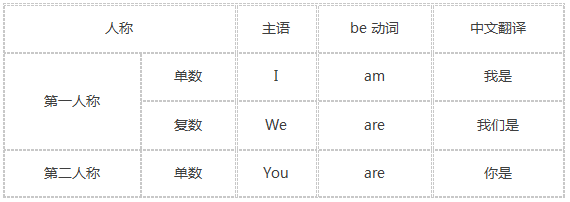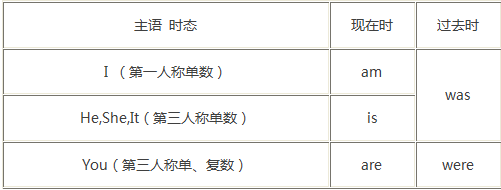- 词类词类
- 名词名词
- 名词的种类名词的种类
- 可数名词与不可数名词可数名词与不可数名词
- 名词的定义名词的定义
- 名词的数名词的数
- 名词所有格名词所有格
- 代词代词
- 代词代词
- 人称代词人称代词
- 物主代词物主代词
- 指示代词指示代词
- 自身代词自身代词
- 相互代词相互代词
- 不定代词不定代词
- 疑问代词、关系代词疑问代词、关系代词
- 冠词冠词
- 冠词的定义冠词的定义
- 冠词的种类冠词的种类
- 不定冠词不定冠词
- 定冠词定冠词
- 名词前不用冠词的情况名词前不用冠词的情况
- 数词数词
- 数词的定义数词的定义
- 数词的词形数词的词形
- 数词的用法数词的用法
- 数词的表示法及读法数词的表示法及读法
- 形容词形容词
- 形容词的定义形容词的定义
- 形容词的种类形容词的种类
- 形容词的位置形容词的位置
- 需注意的形容词用法需注意的形容词用法
- 形容词的比较等级形容词的比较等级
- 形容词比较等级的用法形容词比较等级的用法
- 副词副词
- 副词副词
- 副词的用法副词的用法
- 副词的位置副词的位置
- 副词的比较等级及其用法副词的比较等级及其用法
- 数对常见副词的用法数对常见副词的用法
- 介词介词
- 介词介词
- 介词短语的用法介词短语的用法
- 表示“时间”的介词表示“时间”的介词
- 表示场所、方向的介词表示场所、方向的介词
- 其他介词其他介词
- 介词短语介词短语
- 连词连词
- 连词连词
- 并列连词并列连词
- 从属连词从属连词
- 动词动词
- 动词动词
- be动词be动词
- 一般动词一般动词
- 助动词助动词
- 情态动词情态动词
- 不定式不定式
- 句法句法
- 句子的成分句子的成分
- 句子句子
- 句子的成分句子的成分
- 主语主语
- 谓语谓语
- 表语表语
- 宾语宾语
- 状语状语
- 定语定语
- 基本句型基本句型
- 五种基本句型五种基本句型
- 第1种句型:主语+不及物动词:S+V第1种句型:主语+不及物动词:S+V
- 第2种句型:主语+及物动词+宾语:S+V+O第2种句型:主语+及物动词+宾语:S+V+O
- 第3种句型:主语+系动词+表语:S+V+P第3种句型:主语+系动词+表语:S+V+P
- 第4种句型:主语+及物动词+间接宾语+直接宾语第4种句型:主语+及物动词+间接宾语+直接宾语
- 第5种句型:主语+及物动词+宾语+宾语补足语=S+V(及物)+O+OC第5种句型:主语+及物动词+宾语+宾语补足语=S+V(及物)+O+OC
- 句子的种类句子的种类
- 句子的分类句子的分类
- 陈述句陈述句
- 祈使句祈使句
- 感叹句感叹句
- 疑问句疑问句
- 简单句、并列句、复合句、从句简单句、并列句、复合句、从句
- 时态时态
- 一般现在时一般现在时
- 一般过去时一般过去时
- 一般过去时一般过去时
- 一般过去时的基本用法一般过去时的基本用法
- 辨别正误辨别正误
- 进行时进行时
- 进行时进行时
- 现在进行时现在进行时
- 过去进行时过去进行时
- 进行时的句型进行时的句型
- 现在进行时的基本用法现在进行时的基本用法
- 过去进行时的基本用法过去进行时的基本用法
- 将来时将来时
- 将来时将来时
- 一般将来时一般将来时
- 过去将来时过去将来时
- 完成时完成时
- 现在完成时现在完成时
- 现在完成时的构成现在完成时的构成
- 现在完成时的用法现在完成时的用法
- 过去完成时与现在完成时的比较过去完成时与现在完成时的比较
- 语态语态
- 语态语态
- 被动语态的句型被动语态的句型
- 被动语态的十种时态被动语态的十种时态
- 被动语态的否定句和疑问句被动语态的否定句和疑问句
- 被动语态的几种类型被动语态的几种类型
- 主动语态变为被动语态主动语态变为被动语态
- 被动语态的注意事项被动语态的注意事项
《be动词》be动词
l be动词
be动词是系动词的一种,表示“……是……”的意思。现在式有am,are,is三种。这三种的原形动词是be,所以它们称为be动词。
be动词的句型如下:
肯定句:主语+be动词~。
否定句:主语+be动词+not~。
疑问句:Be动词+主语~?
l be动词的现在时
1.主语与be动词
She is my classmate.
她是我的同学。
be动词的现在式有am,are,is三种,分别接在不同人称的主语之后。下面,我们用图表来表示:

注意
be动词的意义,除了有“……是……”,还有……在……”的意思。
Mary is a student.
玛莉是一名学生。
He is at school.
他在学校。
I am a teacher.(接名词)
我是一个老师。
She is beautiful(接形容词)
她是漂亮的。
She is very beautiful.(接副词)
她是非常的漂亮。
注意
be 动词之后可接不同词性的词。
2. be动词的否定句
I am not a teacher.
我不是一个老师。
be动词(现在时)否定句的结构,如上面例句,只要在be动词am,are,is的后面加not,其句型是:
《主语+be动词+not~.》。
《肯定句》It is a book.
它是一本书。
《否定句》It is not a book.
它不是一本书。
《缩写式》It isn't a book.
《肯定句》You are a student.
你是一位学生。
《否定句》You are not a student.
你不是一位学生。
《缩写式》You aren't a student.
I am not a student.
我不是一位学生。
I'm not a student.
I'm读作['ai m]
be动词否定句的缩写方式
a .is not缩写是isn't,读作[iznt]。
b. are not的缩写是aren't,读作[a:nt]。
c.缩写记号,要放在被省略的字上方。
d. I am~.的否定句是I am not~,缩写为I'm not~.am not,不缩写在起。
3. be动词的一般疑问句
Are you a nurse?
你是一位护士吗?
(1)be动词(现在时)疑问句的结构
其句型是把be动词调到主语前面,即《Be动词+主语~?》。
《肯定句》You are a student.
你是一位学生。
《疑问句》Are you a student?
你是一位学生吗?
(2)一般疑问句的回答方式
a.在回答由be动词构成的疑问句时,要用Yes或No,句型如下:
是Yes,+主语+be动词.
否No,+主语+be动词+not.
注意
Yes或No的后面一定要有逗点,逗点后所加的主语不能大写,除了I(我)例外。
Are you a student?
你是一位学生吗?
Yes,I am.
是的,我是。
注意
问句中的you(你)回答时改为I(我),I永远用大写。
Is your book on the table?
你的书在桌子上吗?
No, it isn’t.
不,它不在。
注意
your book是第三人称单数,回答时要代换为it。
b.在回答的句子中,主语必须是代词。
Is John a student?
约翰是一位学生吗?
Yes, he is.
是的,他是。
Is Mary a nurse?
玛莉是一位护士吗?
Yes,she is.
是的,她是。
(3)用What和 Who等疑问词和be动词构成的问句称特殊疑问句。What用在问句“……是什么?”,Who用在问句“……是谁?”。What和Who的句型是:What(Who)+be动词+主语~?
What is this?
这是什么?
It is table.
它是一张桌子。
注意
回答特殊疑问句时不用Yes或 No。
What are they?
他们是干什么的?
They are workers.
他们是工人。
Who is he?
他是谁?
He is John.
他是约翰。
数种疑问句
What什么
Who谁
Which哪个
Where哪里
When何时
Why为什么
How如何
(4)There is(are)的用法
a.主语是单数名词时用There is
→There is+单数名词+表示场所的字.
主语是复数名词时用There are
→There are+复数名词+表示场所的字.
There is a bed in this room.
这房间里有一张床。
There are many eggs in the kitchen.
厨房里有很多蛋。
b. There is +不定主语~.→The +主语+is(are)~.
在There is的句型中,后面要加不定主语,即用冠词a加在名词前。如果主语为特定物,则用定冠词The加在名词前,并且把句型改成:
The +主语+is(are)~.
There is a book on the table.
桌上有一本书。…(不特定)
The book is on the table
那本书在桌上。…(特定)
c. there的意思
My school is there.这个句子中的there表示“那里”的意思。There is(are)中的there则不是“那里”的意思。当我们要明确地表达“在那里有……”的意思时,则必须重复使用there。
There is a school there.那里有一所学校。
d.There is(are)的否定句与疑问句
There is(are)~.的否定句是在is(are)的后面加not。
疑问句则是将is(are)调到there的前面。
There is not a bed in this room.
这房间里没有一张床。
Are there many eggs in the kitchen?
厨房里有许多蛋吗?
(5) Here的句型
a.《Here is(are)~.》是“这里有……”的意思。
Here are two boys.
这里有两个男孩。
Here is the ticket for you.
你要的车票在这里。
b.主语为名词时,动词在名词之前,主语为代词时,动词在代词之后。
Here comes the teacher.
老师来了。
Here he comes.
他来了。
注意
Here you are.
这个就是。
(口语形式,拿东西给对方时)
l be动词的过去时
be动词过去时的句型如下:
肯定句:主语+be动词的过去式(was,were)~.
否定句:主语+be动词的过去式(was,were)+not~.
疑问句:be 动词的过去式(Was,Were)+主语~?
He was busy yesterday.(肯定句)
他昨天很忙。
He was not busy yesterday.(否定句)
他昨天不忙。
Was he busy yesterday?(疑问句)
他昨天忙吗?
1. be 动词过去时的肯定句
Mike was in the United States last year.
迈克去年在美国。
比较be动词的现在式和过去式:

I was very tired last night.
我昨天晚上很累。
You were absent from school two days ago.
两天前你没到校(缺席)。
There were some books there.
那儿曾经有一些书。
注意
There is(are)的句型用于一般过去时需把is,are变为它们的过去式:There was (were)….
2. be动词过去时的否定句
He was not in Canada last year.
他去年不在加拿大。
be动词过去时的否定句的结构和现在时一样,只要在be动词过去式(was,were)后面加上not就可以了。否定式的was not,were not大多使用缩写形式wasn't(读作>&LQC)和weren't(读作V+:QC)
I wasn't busy the other day.
前几天我不忙。
There weren't any boys in the room.
教室里一个男孩儿也没有。
3. be动词过去时的疑问句(一般疑问句和特殊疑问句)
Was it raining in Beijing yesterday?
No,it wasn' t. It was cloudy.
昨天北京下雨了吗?不,没下雨。昨天北京阴天。
Where were you yesterday morning?I was at school.
你昨天上午去哪儿了?我在学校。
be动词过去时一般疑问句的结构和一般现在时一样,只要把be动词的过去式was,were调到主语前面即可。Was(Were)+ 主语~?回答时,需用yes,was(were)。或No,…wasn't(weren't)。
注意
以疑问词开始的特殊疑问句,回答时,不能用Yes,No直接回答所问的问题即可。
Was your father free this morning?
今天上午你爸爸有空吗?
Yes,he was.是的,他有空。
No, he wasn't.不,他没空。
Was there any water in the bottle?
瓶子里有过水吗?
Yes,there was.是的,曾经有过。
No,there wasn't 不,没有过。
比较
be动词的现在时和过去时句型,以he为主语:
